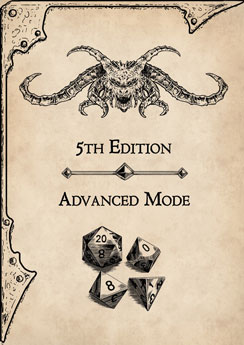Tiny beast (animal), unaligned
Armor Class 12
Hit Points 2 (1d4)
Speed 40 ft., climb 30 ft.
Proficiency Bonus +2
Proficiency Bonus +2 (5th Edition Advanced Mode)
| STR | DEX | CON | INT | WIS | CHA |
|---|---|---|---|---|---|
| 3 (-4) | 15 (+2) | 10 (+1) | 3 (-4) | 12 (+1) | 7 (-2) |
Skills Perception +3, Stealth +4
Senses passive Perception 13
Challenge 0 (10 XP)
Keen Senses. The cat has advantage on Wisdom (Perception) checks that rely on smell, hearing and sight.
Rear Claws (suggested). If the cat hits with both claws, it may rake with both their rear claws dealing 1 slashing damage each as a bonus action. No hit roll required.
ACTIONS
- Multiattack (suggested). The cat can make two attacks with its claws.
- Claws. Melee Weapon Attack: +0 to hit, reach 5 ft., one target. Hit: (1d1) slashing damage.
5th Edition Advanced Mode
Limiting the power of a character and making the overall difficulty of the game harder, does not reduce the creativity, indeed it does quite the opposite.
The Game Master has the option to use any and all of the instances proposed in this guide, or just some of them according to their preference.
It is the lack of something that move and motivate characters, not the abundance of it
DESCRIPTION
A cat is a small, furry, carnivorous mammal that is often kept as a companion or a pest controller. Cats come in a variety of breeds, colors, and patterns, but they all share some common features: a round head, pointed ears, whiskers, a long tail, and retractable claws. Cats are intelligent, curious, and independent creatures that can bond with their owners or other animals. Cats have keen senses of smell, hearing, and vision, especially in the dark. They can communicate with each other and with humans through vocalizations, body language, and scent marking.
COMBAT
Cats are not very effective combatants, as they are small and fragile. They usually avoid direct confrontation with larger or more dangerous foes, preferring to hide, flee, or use their stealth and agility to escape. However, if cornered or threatened, cats can use their claws and teeth to inflict minor wounds. Cats are also adept at climbing and jumping, which can give them an advantage in some situations. Cats are difficult to surprise, as they have a high perception and can sense vibrations and changes in air pressure.
HABITAT / SOCIETY
Cats can be found in almost any environment where there is food and shelter. They are adaptable and can survive in urban, rural, or wilderness settings. Some cats live in the wild, hunting rodents, birds, and other small prey. Others live in human settlements, either as pets or as feral animals. Cats are mostly solitary, but they can form social groups called colonies or clowders. These groups consist of related females and their offspring, who share a common territory and resources. Male cats are usually nomadic or territorial, roaming over large areas and competing for mates.
ECOLOGY
Cats play an important role in the ecology of their habitats. As predators, they help control the population of rodents and other pests that can damage crops or spread diseases. As prey, they provide food for larger carnivores such as wolves, coyotes, or owls. As companions, they provide emotional support and entertainment for humans and other animals. Cats are also valued for their fur, which can be used for clothing or decoration.
